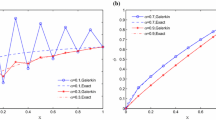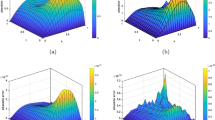Abstract
Due to the nonlocal property of the fractional derivative, the finite element analysis of fractional diffusion equation often leads to a dense and non-symmetric stiffness matrix, in contrast to the conventional finite element formulation with a particularly desirable symmetric and banded stiffness matrix structure for the typical diffusion equation. This work first proposes a finite element formulation that preserves the symmetry and banded stiffness matrix characteristics for the fractional diffusion equation. The key point of the proposed formulation is the symmetric weak form construction through introducing a fractional weight function. It turns out that the stiffness part of the present formulation is identical to its counterpart of the finite element method for the conventional diffusion equation and thus the stiffness matrix formulation becomes trivial. Meanwhile, the fractional derivative effect in the discrete formulation is completely transferred to the force vector, which is obviously much easier and efficient to compute than the dense fractional derivative stiffness matrix. Subsequently, it is further shown that for the general fractional advection–diffusion–reaction equation, the symmetric and banded structure can also be maintained for the diffusion stiffness matrix, although the total stiffness matrix is not symmetric in this case. More importantly, it is demonstrated that under certain conditions this symmetric diffusion stiffness matrix formulation is capable of producing very favorable numerical solutions in comparison with the conventional non-symmetric diffusion stiffness matrix finite element formulation. The effectiveness of the proposed methodology is illustrated through a series of numerical examples.




















Similar content being viewed by others
References
Hughes TJR, Franca LP, Hulbert GM (1989) A new finite element formulation for computational fluid dynamics: VIII. The Galerkin/least-squares method for advective–diffusive equations. Comput Methods Appl Mech Eng 73:173–189
Codina R (1998) Comparison of some finite element methods for solving the diffusion–convection–reaction equation. Comput Methods Appl Mech Eng 156:185–210
Hsieh PW, Yang SY (2016) A new stabilized linear finite element method for solving reaction–convection–diffusion equations. Comput Methods Appl Mech Eng 307:362–382
Borker R, Farhat C, Tezaur R (2016) A high-order discontinuous Galerkin method for unsteady advection–diffusion problems. J Comput Phys 332:520–537
Ciambella J, Paolone A, Vidoli S (2014) Identification of the viscoelastic properties of soft materials at low frequency: performance, ill-conditioning and extrapolation capabilities of fractional and exponential models. J Mech Behav Biomed Mater 37:286–298
Nadzharyan TA, Sorokin VV, Stepanov GV, Bogolyubov AN, Kramarenko EY (2016) A fractional calculus approach to modeling rheological behavior of soft magnetic elastomers. Polymer 92:179–188
Zbiciak A, Kozyra Z (2015) Dynamic analysis of a soft-contact problem using viscoelastic and fractional-elastic rheological models. Arch Civ Mech Eng 15:286–291
Metzler R, Klafter J (2004) The restaurant at the end of the random walk: recent developments in the description of anomalous transport by fractional dynamics. J Phys A Math Gen 37:R161
Shi L, Yu ZG, Mao Z, Xiao AG, Huang HL (2013) Space-time fractional diffusion equations and asymptotic behaviors of a coupled continuous time random walk model. Physica A 392:5801–5807
Jurlewicz A, Kern P, Meerschaert MM, Scheffler HP (2012) Fractional governing equations for coupled random walks. Comput Math Appl 64:3021–3036
Churbanov AG, Vabishchevich PN (2016) Numerical investigation of a space-fractional model of turbulent fluid flow in rectangular ducts. J Comput Phys 321:846–859
Zhang X, Liu L, Wu Y (2014) The uniqueness of positive solution for a fractional order model of turbulent flow in a porous medium. Appl Math Lett 37:26–33
Suzuki A, Fomin SA, Chugunov VA, Niibori Y, Hashida T (2016) Fractional diffusion modeling of heat transfer in porous and fractured media. Int J Heat Mass Transf 103:611–618
Choudhary A, Kumar D, Singh J (2015) A fractional model of fluid flow through porous media with mean capillary pressure. J Assoc Arab Univ Basic Appl Sci 21:59–63
Chen W, Sun HG, Zhang XD, Korosak D (2010) Anomalous diffusion modeling by fractal and fractional derivatives. Comput Math Appl 59:1754–1758
Craiem D, Magin RL (2010) Fractional order models of viscoelasticity as an alternative in the analysis of red blood cell (RBC) membrane mechanics. Phys Biol 7:013001
Miller KS, Ross B (1993) An introduction to the fractional calculus and differential equations. Wiley, New York
Podlubny I (1999) Fractional differential equations. Academic Press, London
Kilbas AA, Srivastava HM, Trujillo JJ (2006) Theory and applications of fractional differential equations. Elsevier, Amsterdam
Baleanu D, Machado JAT, Luo ACJ (2011) Fractional dynamics and control. Springer, New York
Tadjeran C, Meerschaert MM, Scheffler HP (2006) A second-order accurate numerical approximation for the fractional diffusion equation. J Comput Phys 213:205–213
Çelik C, Duman M (2012) Crank–Nicolson method for the fractional diffusion equation with the Riesz fractional derivative. J Comput Phys 231:1743–1750
Li D, Zhang C, Ran M (2016) A linear finite difference scheme for generalized time fractional Burgers equation. Appl Math Model 40:6069–6081
Pang G, Chen W, Sze KY (2016) A comparative study of finite element and finite difference methods for two-dimensional space-fractional advection–dispersion equation. Adv Appl Math Mech 8:166–186
Ying YP, Lian YP, Tang SQ, Liu WK (2017) High-order central difference scheme for Caputo fractional derivative. Comput Methods Appl Mech Eng 317:42–54
Fix GJ, Roof JP (2004) Least squares finite-element solution of a fractional order two-point boundary value problem. Comput Math Appl 48:1017–1033
Zheng Y, Li C, Zhao Z (2010) A note on the finite element method for the space-fractional advection diffusion equation. Comput Math Appl 59:1718–1726
Wang H, Yang D, Zhu S (2015) A Petrov–Galerkin finite element method for variable-coefficient fractional diffusion equations. Comput Methods Appl Mech Eng 290:45–56
Qiu L, Deng W, Hesthaven JS (2015) Nodal discontinuous Galerkin methods for fractional diffusion equations on 2D domain with triangular meshes. J Comput Phys 298:678–694
Zhao Y, Zhang Y, Shi D, Liu F, Turner I (2016) Superconvergence analysis of nonconforming finite element method for two-dimensional time fractional diffusion equations. Appl Math Lett 59:38–47
Luan SZ, Lian YP, Ying YP, Tang SQ, Wagner GJ, Liu WK (2017) An enriched finite element method to fractional advection–diffusion equation. Comput Mech 60:181–201
Lin YM, Xu CJ (2007) Finite difference/spectral approximations for the time-fractional diffusion equation. J Comput Phys 225:1533–1552
Wang H, Zhang X (2015) A high-accuracy preserving spectral Galerkin method for the Dirichlet boundary-value problem of variable-coefficient conservative fractional diffusion equations. J Comput Phys 281:67–81
Chen H, Lü SJ, Chen WP (2016) Finite difference/spectral approximations for the distributed order time fractional reaction–diffusion equation on an unbounded domain. J Comput Phys 315:84–97
Shirzadi A, Ling L, Abbasbandy S (2012) Meshless simulations of the two-dimensional fractional-time convection–diffusion–reaction equations. Eng Anal Bound Elem 36:1522–1527
Liu Q, Liu F, Gu YT, Zhuang P, Chen J, Turner I (2015) A meshless method based on point interpolation method (PIM) for the space fractional diffusion equation. Appl Math Comput 256:930–938
Lian YP, Wagner GJ, Liu WK (2017) A meshfree method for the fractional advection–diffusion equation. In: Meshfree methods for partial differential equations VIII. Lecture notes in computational science and engineering, vol 115, pp 53–66
Lian YP, Ying YP, Tang SQ, Lin S, Wagner GJ, Liu WK (2016) A Petrov–Galerkin finite element method for the fractional advection–diffusion equation. Comput Methods Appl Mech Eng 309:388–410
Samko SG, Kilbas AA, Marichev OI (1993) Fractional integrals and derivatives: theory and applications. Gordon and Breach Science Publishers, Philadelphia
Lions JL, Magenes E (1972) Non-homogeneous boundary value problems and applications. Springer, New York
Li XJ, Xu CJ (2009) A space–time spectral method for the time fractional diffusion equation. SIAM J Numer Anal 47:2108–2131
Tang SQ, Ying YP, Lian YP, Lin S, Yang YB, Wagner GJ, Liu WK (2016) Differential operator multiplication method for fractional differential equations. Comput Mech 58:879–888
Acknowledgements
The support of this work by the National Natural Science Foundation of China (11472233, 11772280) and the Natural Science Foundation of Fujian Province of China (2014J06001, 2014J01208) is gratefully acknowledged.
Author information
Authors and Affiliations
Corresponding author
Rights and permissions
About this article
Cite this article
Lin, Z., Wang, D. A finite element formulation preserving symmetric and banded diffusion stiffness matrix characteristics for fractional differential equations. Comput Mech 62, 185–211 (2018). https://doi.org/10.1007/s00466-017-1492-2
Received:
Accepted:
Published:
Issue Date:
DOI: https://doi.org/10.1007/s00466-017-1492-2




